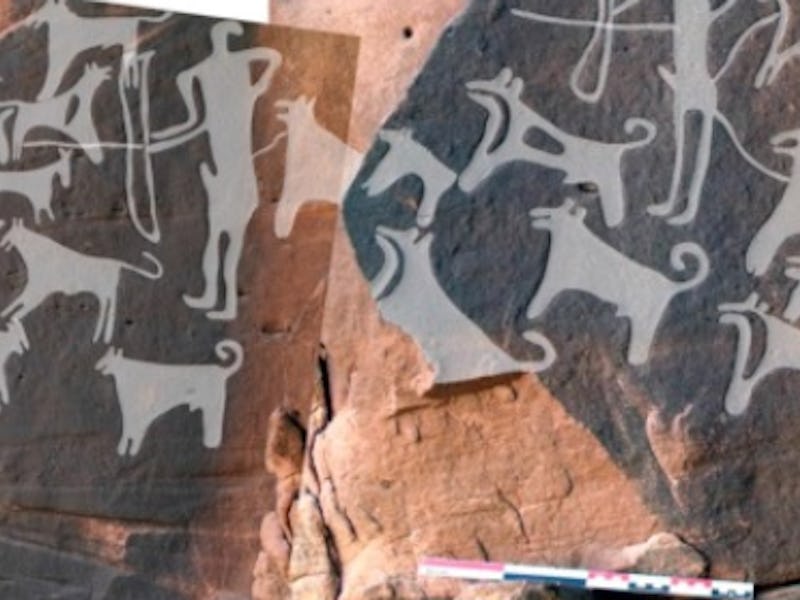Earliest Known Images of Dogs Reveal Origins of Their Bond With Humans
Our modern-day relationship may go back over 8,000 years.

Modern human life is inundated with dog images, with social media users posting an average of six dog photos a week. This endless scroll of good boys and borking puppers has its origins in early human history, a new study in the Journal of Anthropological Archeology shows. The researchers behind the study announced they may have unearthed the oldest images of dogs ever found — and what’s especially curious about those rock art pups is that they all appear to be on leashes.
In the paper, published Thursday, the team of researchers from the Max Planck Institute report that the panels they found on the Arabian Peninsula are between 8,000 and 9,000 years old, which might make them the oldest dog images on record. That title currently belongs to painted pottery found in southwestern Iran that’s also about 8,000 years old, so which is unequivocally the oldest is not yet clear. Nevertheless, both works of early art show similar depictions of dogs: Canines with short snouts, upturned, curled tails, and pricked ears — similar to modern day Canaan dogs.
“Seeing the images was a great feeling,” co-author Angela Perri, Ph.D., a post-doctoral researcher at the Max Planck Institute for Evolutionary Anthropology who studies ancient hunting dogs, tells Inverse. “This rock art gives us a snapshot into the lives of the people of this region and their relationship and use of hunting dogs.”
Perri says that this extremely rare, old find is especially exciting because it shows how humans and dogs actually interacted. Images, she says, are worth more than excavated bones when it comes to understanding a relationship.
The top image is a traced version of a engravings depicting dogs, humans, and cattle.
Perri was shown the images by Maria Guagnin, Ph.D., an archeologist with the Max Planck Institute for the Science of Human History that had been excavating the sites of Shuwaymis and Jubbah, in northwestern Saudi Arabia, while working on research project called Palaeodeserts. The project began in 2013, and Guagnin joined in 2014, after which she was given the data set on the dog engravings and, she tells Inverse, became “immediately struck.”
Her team’s analysis showed that 52 of the rock art panels found in Shuwaymis depict dogs, and 127 of the panels found in Jubbah depict the same. In the panels, the dogs are hunting lions and pursuing ibex as well as herding cattle, and many of them are on leashes.
“It took a couple of years of research to establish a chronological sequence — the scale of the discovery only became clear once we combined the knowledge I have of the rock art and archaeology of the region, with the knowledge Angela Perri has of dog domestication,” says Guagnin.
“We both got really excited when we realized we might have the oldest depiction of leashes, and that images may give us a lot of information on dog domestication and the use of dogs in complex dog-assisted hunting strategies.”
The dogs depicted appear similar to the modern day Canaan dog.
The leashed dogs depicted on the panels are thought to be the oldest depiction of that interaction. It appears that the leashes are tied to the waists of the humans, which would allow hunters to have their hands free to use bows and arrows. In some of the images, the hunters have individual dogs leashed to them, and others have multiple attached.
“We can finally show how pre-Neolithic humans controlled their dogs, and how they used them in hunting strategies,” says Guagnin.
“We now know that dogs probably performed different tasks, that different types of prey were hunted using different strategies, and that humans were able to utilize dog-assisted hunting to adapt to different environmental settings.”
Satellite images of Shuwaymis (bottom left) and Jubbah (bottom right).
The team confidently dates the art as pre-Neolithic, citing their analysis of the weathering of the panels, their content, their location, and their association with “late markers” (other representations, like images of a camel). However, other experts caution that more work needs to be done to confirm the age of the images and their meaning in context. Guagnin says that the Palaeodeserts team has plans to continue their work in the region, and hope that new discoveries at the sites will tell them more about the prehistoric populations that created these images.
The timing of dog domestication and where it first took place remains a point of archeological debate — it’s thought that domestication began about 15,000 years ago, but genetic findings suggest that it could have happened 40,000 years ago. Regardless, the images clearly depict a close working relationship between dogs and humans, which offers some clues to when that relationship began — and perhaps some insight into how it’s strengthened over the years.